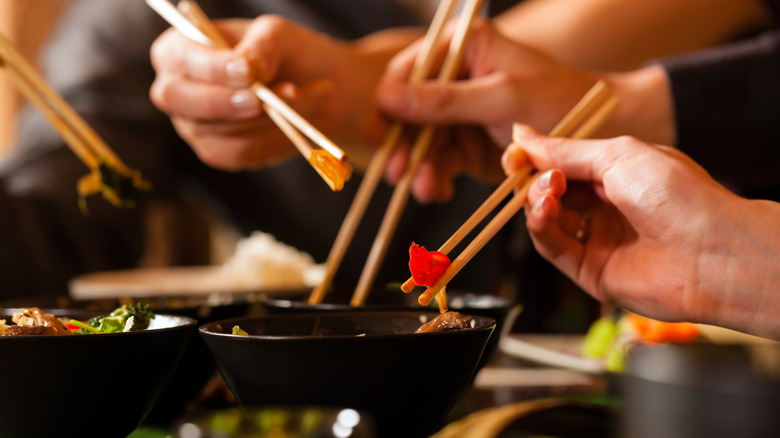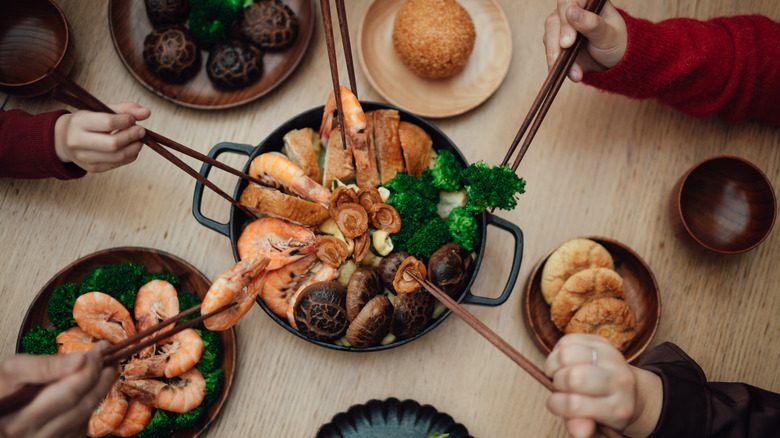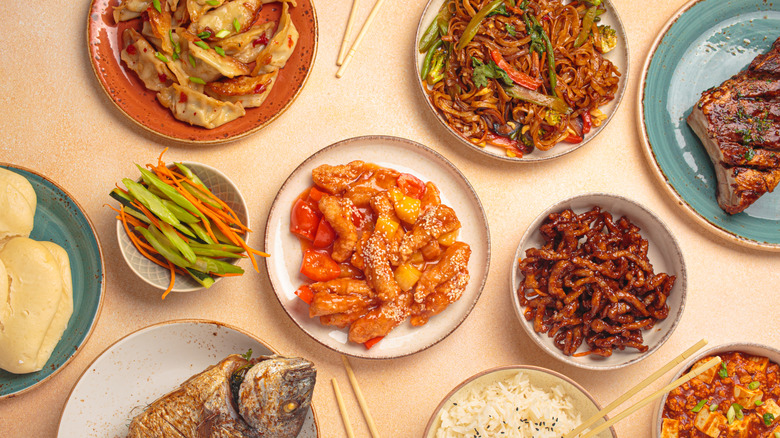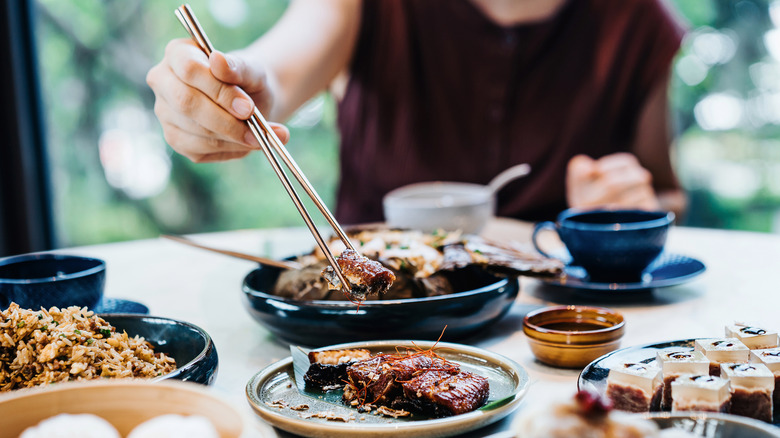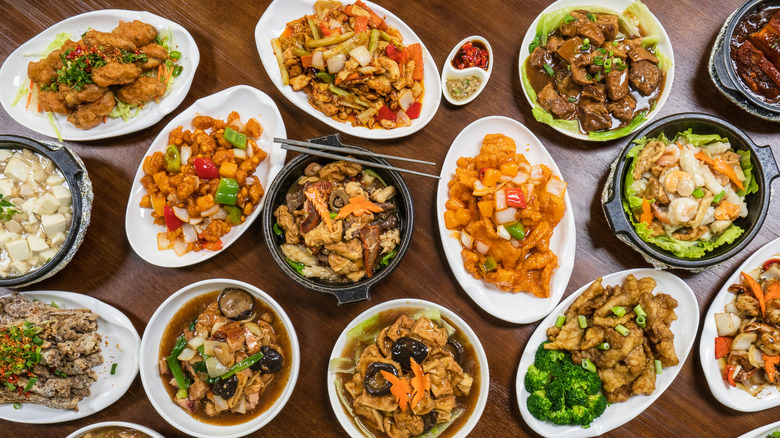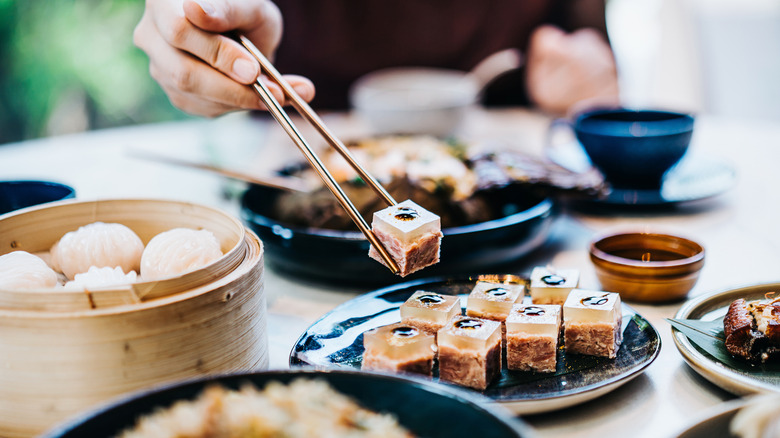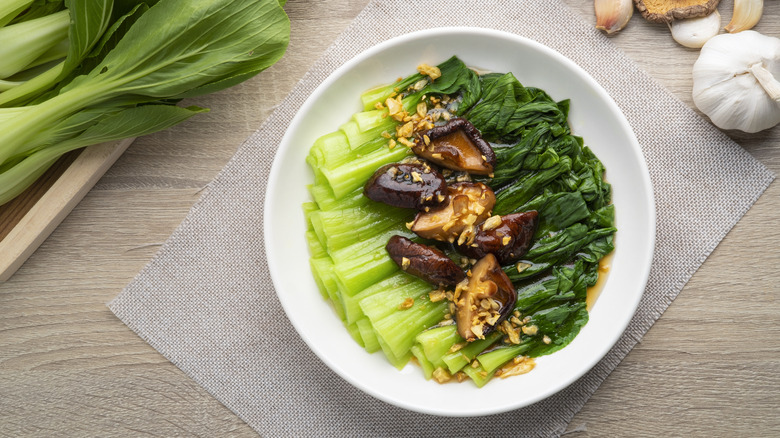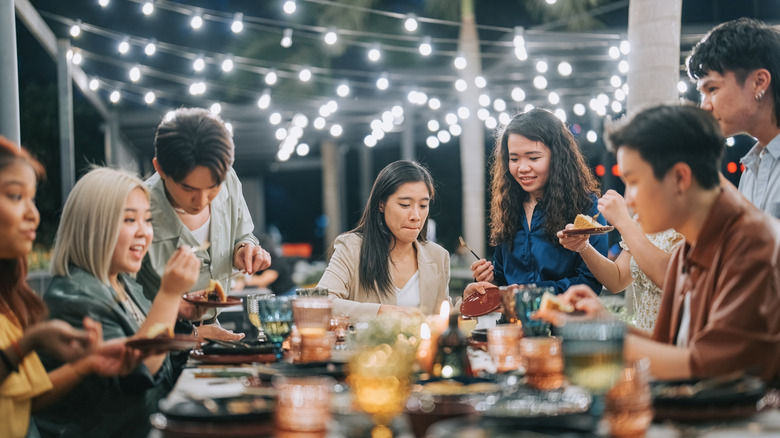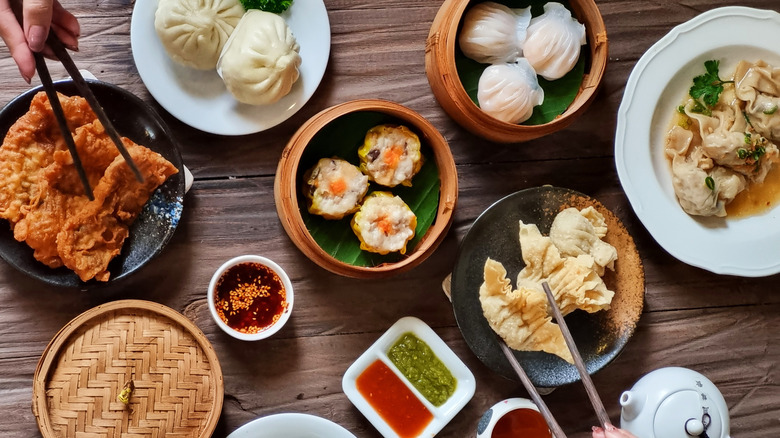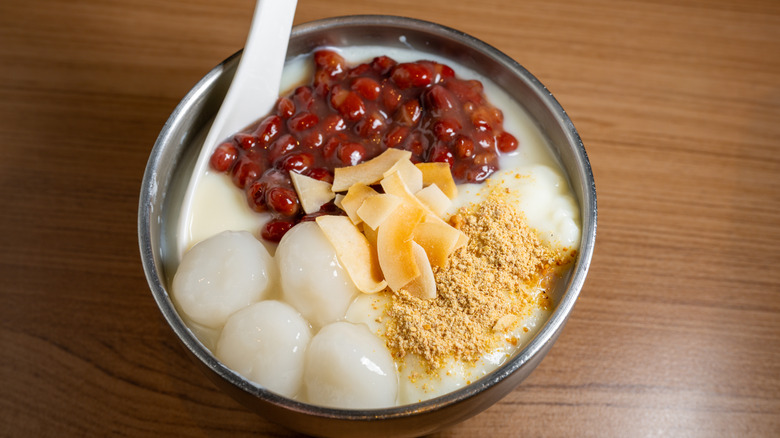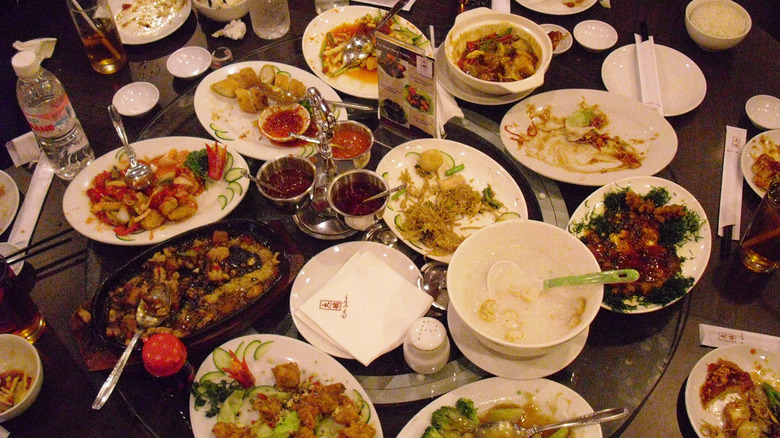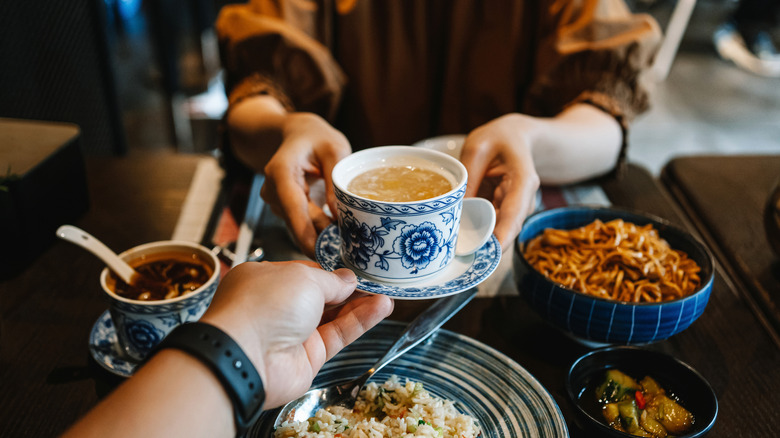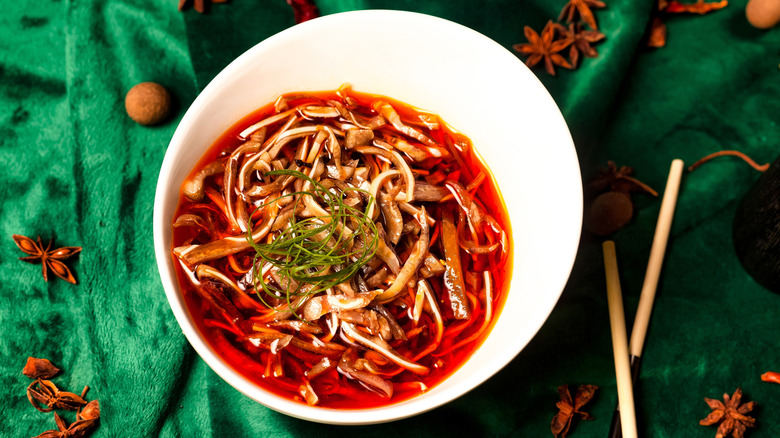12 Mistakes Everyone Makes Eating At A Chinese Restaurant, According To Chefs
Going out for Chinese food is never a bad idea, whether you have an old neighborhood favorite or you're trying the hottest new joint in town. But there are some mistakes everyone makes when eating at Chinese restaurants. From ordering individual dishes for each diner to shying away from traditional ingredients and flavors, there are various ways you can go wrong. It's not the end of the world, but you might have a better experience if you learn from the pros.
To understand common Chinese restaurant mistakes, we went to the experts. We talked to James Fu, the corporate chef at Din Tai Fung, and sisters Sarah and Kaitlin Leung, recipe developers at The Woks of Life and authors of a bestselling cookbook of the same name. They outlined some of the most common missteps diners make and what to do instead. A little curiosity and a few simple shifts in ordering and etiquette will make meals more authentic, more exciting, and tastier.
Not ordering food family style
One of the simplest ways to miss out at a Chinese restaurant is to treat the meal like a solo plate. In most Chinese dining cultures, meals are family style: multiple dishes come to the center of the table, and everyone helps themselves. This is why lazy Susans are common on larger tables in Chinese restaurants. Ordering in this way gives you a more balanced meal and means you get to try more dishes.
"Probably the biggest mistake, at least from a cultural perspective, is when people order individual entrees at a Chinese restaurant," Sarah and Kaitlin Leung tell us. "A Chinese meal is meant to be served family style," they add. James Fu agrees that sharing plates is the way to go at a Chinese restaurant, giving diners the best experience.
If you're used to individual entrees, you might struggle to know how much to order. While this can vary depending on appetite or preference, on average, you want to order one dish per person, plus one or two — more for a larger table than a smaller one. This should be a range of dishes, not just proteins. Rice isn't usually included in this equation, while noodle dishes may or may not be. Family-style dining isn't just about logistics. It's how the cuisine is meant to be enjoyed. So, embrace it and don't hog your favorite plate.
Assuming Chinese food only spans a narrow range of dishes
If your experience begins and ends with sesame or General Tso's chicken, you're only trying Chinese food you won't find in China. Many American Chinese staples were adapted to local palates decades ago. They aren't wrong, but they're not the whole story, either. Plus, once you get to authentic Chinese cuisine, there's a huge amount of variation.
"Chinese food is extremely diverse, known for distinct regional flavors," says Din Tai Fung chef James Fu. "It can be difficult to compare one region to another, as the flavors and recipes can taste entirely different, even if they have the same name or base ingredients." He notes that the Taiwanese-style soup dumplings served at Din Tai Fung differ from the better-known Shanghai style, for instance, though both are delicious and require skill to make.
"What you might find at a Chinese American takeout restaurant is very different from what you might find at a Sichuan restaurant, a Hunan restaurant, a Shanghainese restaurant, or a restaurant that specializes in one dish, like Lanzhou Beef Noodle Soup," Sarah and Kaitlin Leung explain. Understanding that variety changes how you order and what you'll enjoy. If you like spicy food, seek out Sichuan or Hunan specialties (mapo tofu, dry-fried green beans, smoked chili dishes). Want rich braises and sticky-sweet sauces? Try Shanghai-style dishes. Branching out means you'll try so much more great food.
Cherry picking your favorite bits from a dish
When dishes arrive family-style, it's tempting to go straight for your favorite parts. That impulse is understandable, but in a shared Chinese meal, it's considered poor form. "Never pick through a dish for items you like and leave behind items you don't," remark Sarah and Kaitlin Leung, authors of The Woks of Life.
Picking out only the bits you like shortchanges everyone at the table and upends the balance the chef planned. Many Chinese dishes are built around contrast. They have contrasting textures, pair fatty with acidic, and balance savory with bright notes. If you cherry-pick your preferred pieces, you miss how those elements play together.
Plus, if everyone plucks out the most crowd-pleasing morsels, the table winds up with the leftovers nobody planned on eating, and the overall composition falls apart. So, resist the urge to just eat the protein out of a dish and make sure you take veggies, as well. You'll ultimately get a better plate, and nobody at the table will have to be annoyed that you took all the best bits.
Not ordering a balanced selection of dishes
We've talked about dining family styles, but one of the easiest ways to have an underwhelming meal is to let everyone order their own favorite dish without thinking about the spread as a whole. A dining table needs contrast. There should be vegetables to cut richness, perhaps a soup or light dish to reset the palate, and starchy anchors such as rice or noodles to carry sauces.
James Fu recommends sensible variety: "Diners can get the most out of Din Tai Fung by ordering varieties from each category, such as a noodle or rice dish, with a vegetable, and a soup." He adds that his restaurant (and others) offer "a mix of flavors, formats and ingredients that are meant to be complementary to each other." Diners get the best meal when they mix and match these kinds of dishes.
Similarly, Kaitlin and Sarah Leung remind us that "a Chinese meal is meant to be served family-style — multiple dishes that represent a good balance of various proteins and vegetables — and shared amongst the entire table. According to the pair, "as you choose dishes, make sure they're in balance — try various proteins, and make sure you have a vegetable dish and perhaps a tofu dish and/or a soup." So, take some time to think about the meal as a whole, as well as taking individual preferences into account.
Using chopsticks incorrectly
Chopsticks come with their own etiquette, and not all of it is intuitive if you didn't grow up using them. Some faux pas are harmless, but others carry cultural baggage. One common mistake to avoid entirely is a gesture that resembles funeral rites. "One we'll see often is sticking chopsticks vertically in the middle of your rice or noodle dish," James Fu warns. "Historically, this is a symbol of bad luck because it resembles the incense sticks used during funerals."
Beyond that, a few rules will keep things polite and tidy. Don't spear food with chopsticks like a fork. Avoid using chopsticks to point or gesture. When you're not using them, lay chopsticks on a plate or on a provided chopstick holder instead of crossing them over bowls. If you're sharing, use another set of chopsticks or serving utensils to transfer food to your plate, not the ones you've been eating with.
If you're not sure what you should be doing with your chopsticks or how to use them, don't worry. While you may want to learn, it's also alright to politely ask for a fork or spoon. It's better to stick with utensils you're confident using than to make a restaurant faux pas.
Avoiding greens
The likelihood is that greens are one of the things you're missing out on at a Chinese restaurant. It might not seem like the most exciting dish on the menu, but veggies like bok choy, gai lan, choy sum, and even simple spinach take on a new life when dressed with garlic, soy, sesame oil, or oyster sauce."A stir-fried leafy green is one of the best and tastiest dishes you can order at a good Chinese restaurant," according to Kaitlin and Sarah Leung. "The high heat of the wok and wok-hei flavor makes leafy greens taste amazing, and we often see folks miss an opportunity to really appreciate vegetables."
Greens bring contrast. Bright, bitter, and crunchy notes that cut through richer plates. Some dishes use simple acid or fermented bean pastes to lift flavor; others rely on the flavor of the vegetable and some perfectly timed wok heat. Ordering a leafy dish both balances the meal nutritionally and balances the flavors and textures. Give the greens a try. You might be surprised how memorable they are.
Ignoring Chinese dining etiquette
Chinese table manners aren't just arbitrary rules. They are ways of showing respect to the food and the people you're eating with. Small gestures matter: offer dishes to others before serving yourself, transfer shared food onto your own bowl rather than eating directly from the communal plate, and eat your dim sum one at a time rather than loading multiple onto your plate. Nobody's going to kick you out for ignoring Chinese dining etiquette, but at least attempting to get it right shows respect for the culture and the space.
It's polite to keep an eye on the levels of tea in people's cups and refill them if they get low, note Sarah and Kaitlin Leung. If someone refills your teacup, tap the table lightly with your index and middle fingers to say thank you, and when handing a cup, use both hands as a sign of respect. And, even if it's your favorite one on the table, you should always offer the last dumpling to others before taking it for yourself. Little adjustments go a long way toward showing cultural awareness and making communal dining more enjoyable.
Sticking to the same dishes every time
"I'd suggest trying a new dish on the menu during each visit," says James Fu of Din Tai Fung. The variety is one of the best things about Chinese dining. So, if you're always ordering the same old thing, you're making a mistake. China's culinary map is enormous — Sichuan, Cantonese, Hunan, Jiangsu, Fujian, Xinjiang, and countless local traditions each have distinctive techniques, ingredients, and flavor profiles. Limiting yourself to the familiar staples means you won't experience something new.
We understand wanting to get your go-to dish — one you look forward to and you know you enjoy. But you're limiting yourself, and you might miss out on discovering your new favorite. Many restaurants will gladly recommend dishes based on what you like, so use the staff as a resource. Ordering family-style helps you sample more without committing to a whole new entrée yourself, which is another great reason to do it. This allows you to be more adventurous, trying new dishes alongside old favorites. Yes, it can be tough to step outside your comfort zone, but the rewards are worth it.
Staying away from traditional dessert flavors
Some dessert flavors might be unfamiliar to anyone who doesn't come from a Chinese background, but by ignoring them and only going for the ones you know, you're missing out. "I'd love for more guests to try the traditional dessert flavors that Din Tai Fung offers in dumpling and bun form," says James Fu. And, naturally, that goes for any Chinese restaurant you visit.
There may be flavors on the menu you haven't tried before, and you should absolutely check the various types of Chinese dumplings and desserts that your chosen restaurant has to offer. "The red bean, taro, and black sesame are incredible and are often underestimated by diners," Fu remarks. "While our bestselling dessert at the restaurant is the Chocolate and Mochi Xiao Long Bao, my personal favorite is the Black Sesame," he adds, noting that it's nutty and rich with just the right sweetness level. You might be tempted to go with what you know, like chocolate or vanilla, but there's a whole new world of desserts out there you need to try.
Leaving a lot of food on your plate
There's a practice that says leaving a small amount of food on your plate shows that the host provided more than enough. However, treating that idea as universal advice is risky. Travelers have experienced the opposite and have been told that completely finishing what's been served is respectful to the ingredients and the people who produced them. Of course, customs vary widely across regions and settings.
In US-based Chinese restaurants, you likely don't need to consider leaving a few bites behind. However, leaving a large amount can signal that you don't care about waste or that you didn't enjoy the meal. Wasting food is frowned upon and shows a lack of regard for the farmers who put so much effort into producing the ingredients.
Nobody's asking you to eat food that you genuinely don't have room for, but try not to order so much food that you'll never get through it all. If you can't finish something, request a takeout box rather than leaving it. After all, Chinese food is perfect for reheating and enjoying the next day.
Not serving your elders first
Serving elders first and waiting for them to begin eating is a sign of respect in many Chinese dining contexts. The gesture acknowledges seniority and shows you honor their place in the family or group. "Younger people at the table shouldn't start until the elders have started eating first," Kaitlin and Sarah Leung tell us. So, if someone older than you is present, it's polite to wait until they start before digging in.
If you're passing a dish, offer it to older diners before younger ones. When pouring tea, present the cup with both hands when serving someone older than you. And a quick check of the table to see whether elders have started is a thoughtful habit. Of course, you aren't obliged to follow these kinds of social norms, especially in an American Chinese restaurant. However, there are some contexts when it would be important to know this, such as if you're dining with a group in China. Even so, it never hurts to follow these kinds of traditions, even when it's not strictly necessary.
Ignoring the option of customized spice levels
Americanized Chinese menus often tone down fiery regional specialties so they're broadly palatable. That's convenient, but it can also mean you miss the real personality of a dish. The better move is to ask about spice levels and customize them to your taste. Many restaurants are used to this and will adjust based on your preferences.
When ordering, be specific. Ask the server how their kitchen handles heat: does "medium" mean a gentle warmth or a mouth-numbing hit? For dishes from Sichuan or Hunan provinces, mention whether you want the numbing (mala) effect or prefer straight chili heat. Or, perhaps you have the opposite issue. You have limited spice tolerance. Servers can often recommend levels and tone it down if needed.
Some Chinese restaurants offer customizable spice levels as standard, asking all diners if they'd prefer it mild, medium, or spicy. In other establishments, you have to ask — and be prepared that it may not be possible for every dish. In some cases, the sauce may have been cooked in advance, so reducing the heat isn't an option. But it doesn't hurt to try. It means you'll be more likely to enjoy your meal.
